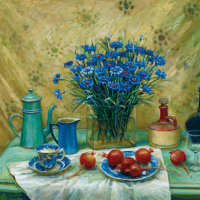13. MARGARET OLLEY

Margaret Olleys Duxford Street terrace house was brimming with collected objects used primarily for picture-making. The endless array of fruit bowls, ceramic jugs, lamps, vases of flowers, painted plates, woven baskets and glass bottles were acquired by Olley specifically to be included in her still-life paintings. Just two years before Cornflowers with Pomegranates was painted, Olley explained in an interview that, the subject matter is not important; it is the shape, the placement and the pictorial relationship which concerns me.1 The wine glass we see here is not about to be filled with wine, nor the teacup with tea, and the pomegranates were not picked for eating; these objects exist in this space strictly as aesthetic entities to be painted. Such is the seriousness with which Olley tackled the still-life genre.
For Olley, still-life painting was a lifelong love. It is clear why, when each of her paintings is a visual essay in composition and aesthetics. Not one to conform to artistic trends, she showed little regard for the contemporaneous movements of abstraction and minimalism. Her commitment to still-life was not incidental through lack of exposure to other subjects or movements. On the contrary, Olley travelled extensively and was well-versed in local and international art scenes. As curator and writer, Christine France, stated, although she is well aware and tolerant of the current trends, Margaret Olley makes no stylistic concessions to fashion in her painting.2
Flowers were Olleys favourite subject, usually forming the centrepiece of her compositions. Olley appreciated flowers for the dynamism that their bright colours and lively forms brought to her paintings. For example, in the present work the brilliant blue of the cornflowers seems to spill forth onto the milk jug, teacup and plate, as though contagious. The cornflowers, with their scrappy stems and intricate petals, provide an organic and exuberant counterpart to the surrounding stagnant manmade objects. Throughout her life, Olley depicted countless varieties of flowers, including delphiniums, calendulas, hydrangeas, poppies, marigolds, flannel flowers, hippeastrums and more, prompting James Gleeson to dub her, a symphonist among flower painters.3 Olleys love of flowers is currently being celebrated in the exhibition Margaret Olley: The Art of Flowers at the Tweed Regional Gallery & Margaret Olley Art Centre, New South Wales.4
Another device Olley often used to bring softness and texture to her paintings was a rumpled swathe of fabric. These cloths are usually draped over the edge of a flat tabletop, falling out of sight beyond the picture frame. This extends the composition, adding depth and spontaneity, ensuring the neat arrangement of objects does not appear staged. In Cornflowers with Pomegranates Olley has also used a patterned fabric as the backdrop, again adding texture and warmth. These components combine to create a quintessential Margaret Olley painted at the peak of her career.
Throughout her life, Olley held over ninety solo exhibitions and won eighteen art prizes and awards. She was formally declared an Australian National Treasure in 1997, and even now her success continues to grow: last year, a decade after her death, her previous auction record of $158,600 set in 2013 was surpassed on three separate occasions. The joy and esteem that her still-lifes have elicited from Australian audiences for over six decades is remarkable.
Footnotes:
1. Margaret Olley in an interview with Christine France, 22 March 1989, quoted in France, C., Margaret Olley, Craftsman House, Sydney, 2002, p.11
2. France, C., op. cit., p.49
3. Gleeson, J., Introduction, Paintings by Margaret Olley [exhibition catalogue], The Johnstone Gallery, Brisbane, 1964
4. Margaret Olley: The Art of Flowers, Tweed Regional Gallery & Margaret Olley Art Centre, New South Wales, 7 September 2022 - 12 March 2023
Asta Cameron